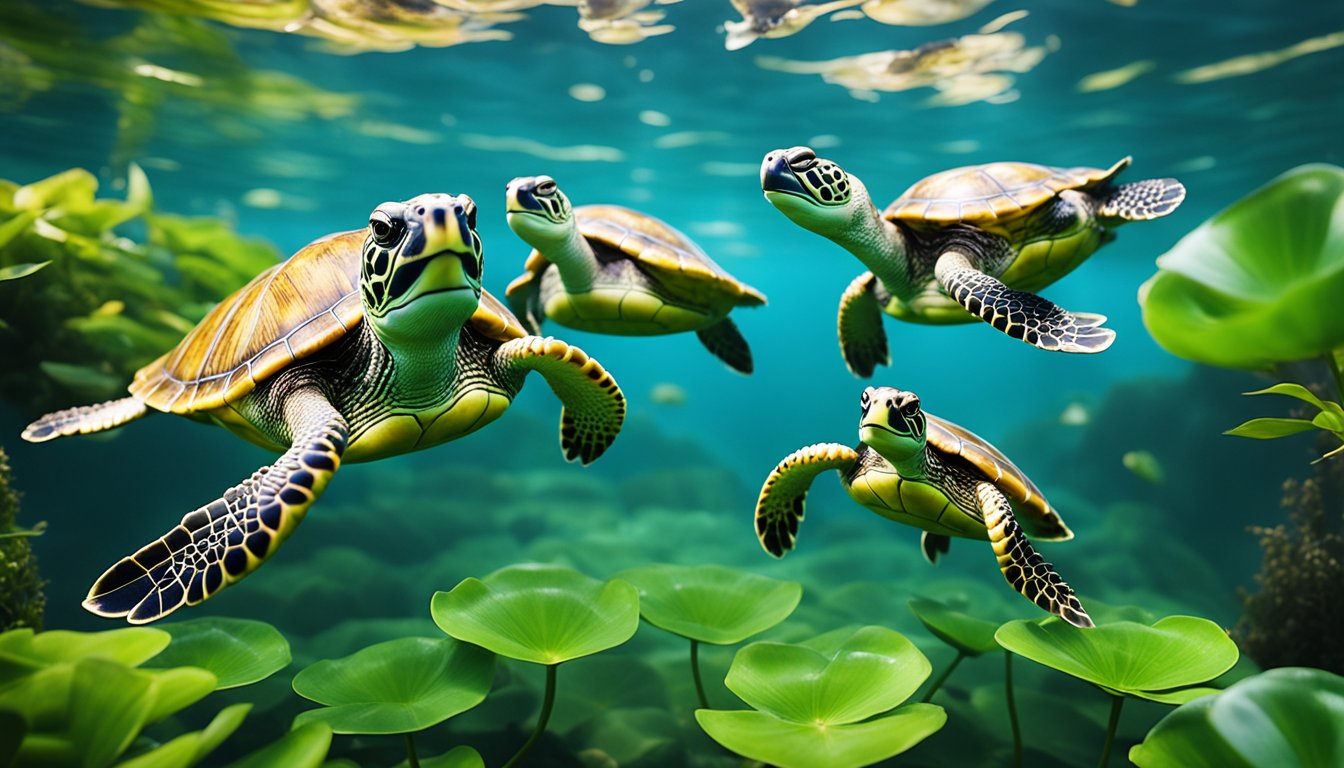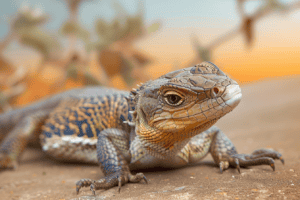Picture this: a shelled explorer who carries its home on its back, plodding along at its own pace.
Turtles have been roaming the earth for millions of years, long before humans or even dinosaurs, which makes them one of the oldest creatures on the planet.
With their distinctive shells and leisurely walks, turtles are fascinating animals that inhabit various environments.
Young explorers often marvel at these resilient reptiles who come in all sizes and shades.
They have remarkable habits and traits, from their diet to their incredible long-distance migrations.
Some turtles are tiny enough to fit in the palm of your hand, while others are as massive as a small car!
Understanding turtles unlocks a world of wonder beneath the waves and on land.
These creatures are important to ecosystems since they help maintain healthy environments.
By learning about their diet, habitat, and behavior, young explorers become more connected to the intricate web of life that sustains us all.
Let’s take a closer look at some of the most enjoyable and surprising facts about these extraordinary reptiles.
Exploring the Shell: A Turtle’s Mobile Home
Imagine wearing your house on your back, being able to take shelter wherever you go – that’s exactly what a turtle does with its shell!
A turtle’s shell isn’t just a home, it’s a cleverly designed shield that protects these adorable reptiles from predators and harsh weather.
The shell is made up of two parts: the carapace on the back and the plastron on the belly.
These two parts are connected by a bony bridge, making the shell a tough suit of armor.
Despite this toughness, the shell is not lifeless; it’s a growing, living part of the turtle, with blood vessels and nerves throughout.
Have you ever wondered what a turtle’s shell is made of?
It’s not just bone; it’s also overlaid with scutes, which are made of keratin – the same material human nails are made of!
Some turtles can even tuck themselves completely inside their shells when danger lurks nearby.
This fantastic feature is like having a built-in safety bunker!
Whereas, other turtles, like the leatherback sea turtle, have softer, more leathery shells that let them dive deep into the ocean.
Ever thought about the color of a turtle’s shell? The hues can range from browns to greens, and sometimes even vibrant yellows or reds.
These colors can help turtles blend into their environments, be it a sandy beach or a murky pond, making it a built-in camouflage cloak.
Turtles aren’t just carrying a home; they’re equipped with an amazingly versatile tool for survival.
The shell grows as they grow, ensuring they always have a perfect fit.
It’s truly fascinating how nature has equipped these creatures for life’s journey, don’t you think?
The Age-Old Journey: How Turtles Have Changed Through Time
Turtles are one of the oldest creatures on our planet, and their journey through time is nothing short of remarkable.
They’ve been paddling through the seas and trudging along our lands for over 200 million years!
From Ancient Ancestors to Modern Species
Imagine a time before dinosaurs roamed the Earth; that’s when the first turtle ancestors appeared.
Protostega and Archelon were ancient marine turtles that swam in the ocean during the Cretaceous period.
These giants were much larger than today’s turtles, with Archelon reaching up to 15 feet in length—almost as long as a volleyball court!
As time went on, during the adaptation extravaganza known as evolution, turtles split into various species.
Changes in their habitats and climates meant that turtles had to adapt or face extinction.
They’ve developed unique traits like hard shells for protection and different types of beaks for their diverse diets.
It’s a bit like how you pick out your shoes for the day. If it’s raining, you’d wear boots, right?
Well, turtles that munch on plants have flat beaks to crush and grind their leafy snacks, while meat-eating turtles sport sharp beaks to snag their prey.
One of the most extraordinary adaptions of these ancient creatures is their expansive home range.
Turtles can be found on every continent except Antarctica.
How’s that for a globetrotting lifestyle?
While the oldest turtle fossil, Odontochelys semitestacea, shows a turtle with a full toothed mouth and a partial shell, modern turtles are entirely toothless and boast a full protective carapace and plastron.
This evolutionary journey from toothy grins to toothless wonders shows just how much they’ve changed to survive.
Turtle Talk: Understanding How Turtles Communicate
Did you know that turtles have their own unique way of “talking” to each other?
While they don’t use words like we do, they have a special method of communication that’s just as interesting.
The Language of Shell Tap Codes
Imagine if you could chat with your friends by tapping on your backpack at school. Turtles use something quite similar!
When turtles want to communicate, they sometimes tap on each other’s shells.
This tapping can mean different things, like “hello there!” or “this is my spot.” Each tap is like a code that sends a message to another turtle.
It’s not as complex as human language, but it certainly does the trick in the turtle world.
So, next time you see a turtle, pay close attention. You might just witness a turtle conversation in action!
Isn’t it fascinating how even without words, these shelled friends have their own way to talk?
Uncovering Turtle Habitats: From Land to Sea
Turtles have an incredible range of homes, from the murky waters of freshwater rivers to the vast depths of the oceans and even on solid ground.
These resilient creatures adapt to their environment, showcasing a stunning diversity in habitats.
Freshwater Friends
In meandering rivers, serene lakes, and even in swamps, freshwater turtles feel right at home.
They bask on logs or rocks that peek above the water’s surface, soaking up the sun.
Most freshwater turtles have webbed feet and sleek shells that help them glide with ease through the water.
They’re exceptional swimmers, but unlike their sea-going cousins, they can’t handle salty water.
Ocean Explorers
Sea turtles are the mariners of the turtle world, navigating across oceans.
They travel thousands of miles and can often be spotted in shallow coastal areas, as well as the open sea.
Unlike freshwater turtles, sea turtles have flippers that make them skilled and graceful swimmers.
They can dive to great depths and remain underwater for hours, especially when resting or hiding from predators.
Land Lovers
Not all turtles are fond of the water. Tortoises, for example, spend their days on land.
They have sturdy, dome-shaped shells and strong, column-like legs suited for life away from water bodies.
They’re often found in a variety of land habitats including deserts, grasslands, and forests, roaming in search of food and basking in the sun.
Frequently Asked Questions
Embark on a fascinating journey to uncover the secrets of turtles with these questions young explorers frequently ask!
What kind of shells do turtles have, and why are they so unique?
Turtles wear a remarkable shield called a shell, made up of over 50 bones fused together.
This living case, unique as their fingerprint, not only shelters them from predators but also helps them blend into their surroundings.
It’s like carrying a personal hideout everywhere they go!
Can you tell me how turtles hatch and begin their life journey?
Imagine breaking out of a tough, leathery egg with your tiny egg tooth, that’s how a turtle’s adventure begins.
They dig out of the sand and race to the ocean, guided by the brightest horizon, kickstarting a life full of oceanic voyages.
How do sea turtles help keep ocean ecosystems healthy?
Sea turtles are the caretakers of the seas. By munching on seagrass, they keep it short and healthy, which benefits all the other sea creatures.
It’s as if they’re underwater gardeners, fostering life beneath the waves by ensuring their underwater gardens flourish.
Why do some turtle species travel so far, and where do they go?
Travelers by nature, certain turtle species embark on epic journeys, swimming thousands of miles between feeding sites and nesting beaches.
They may roam from chilly waters near Canada all the way to the warm coasts of Mexico, all in the pursuit of the perfect spot to dine or lay their eggs.
What’s the difference between turtles and tortoises?
Turtles and tortoises are shelled cousins.
Turtles prefer a dip in the water with webbed feet or flippers, while tortoises are land-lovers sporting rounder, heavier shells and elephant-like, stumpy feet for strolling on the earth.
How can we help protect turtles and their habitats?
We can be heroes for turtles by keeping beaches clean, reducing plastic use, and protecting the sea where they live.
Every time a person helps reduce pollution, they give turtles a cleaner home and a better chance to thrive.
Engage your curiosity, encourage friends and family to learn more, and become an ally to these incredible shelled adventurers!









